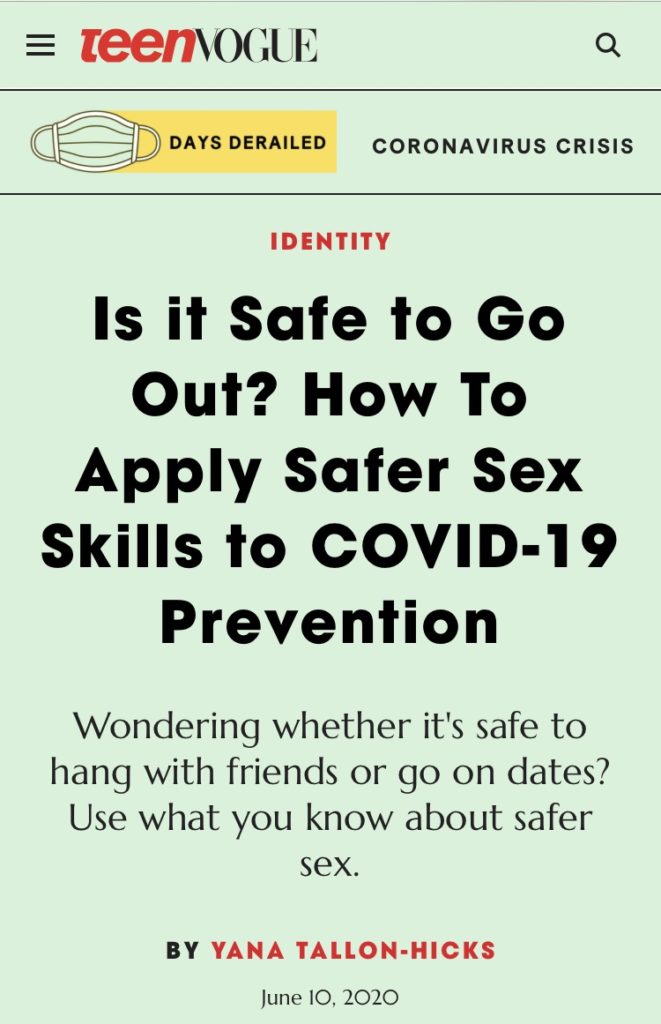
On Teen Vogue: How To Apply Safer Sex Skills to COVID-19 Prevention
Wondering whether it's safe to hang with friends or go on dates? Use what you know about safer sex.
The international COVID-19 crisis has forced us all to learn so many new skills — from how to make the perfect sourdough starter, to how to offer mutual aid with zero contact, what 6 feet apart really looks like, and how to tap into our resources so that we can take care of ourselves, each other, and people we don’t even know. The learning curve has been steep, quick, and ever-changing.
As a sex educator and therapist, I’ve spent the last few months working from home and fielding questions about dating, sex, and intimacy during COVID-19: Now that states are re-opening, can I go on a date? Hold hands? Make out? Have sex? How do I know what’s safe?
The COVID-19 pandemic has not been solved, and there is no vaccine. Still, states are re-opening, and many of us are eager for relief from our social isolation. As we start to re-enter the world, we’ll face choices about how, when, and with whom we want to interact with others. And, we might find ourselves wondering when we can really get close to others. We miss people, we miss touch, and we just want to kiss our virtual crush already!
There is so much we still don’t know about COVID-19 and what impacts of this virus will be. Luckily, there are many things we do know about navigating personal risk when it comes to physical intimacy, thanks to comprehensive safer sex education. Just as with sex during normal times, being physically close to anyone during the COVID-19 pandemic carries risks and rewards. So, we can use the knowledge we have about safer sex practices, and apply it to general contact with others during the COVID-19 pandemic.
While absolute, no-contact, social isolation is the “abstinence” of the COVID-19 crisis, the reality is that human beings are social (and, many of us, sexual) creatures, willing to take some managed risks to experience benefits such as social contact, physical touch, pleasure, love, attachment, decreased depression and anxiety, and community closeness.
To help me dig into the details of how, I spoke to two infectious disease experts with sex educational backgrounds: Nadine M. Finigan-Carr, Ph.D., director of Prevention of Adolescent Risks Initiative at University of Maryland School of Social Work who is also a trained sex educator and prevention research scientist and Lisa M. Lee, a research professor in population health sciences and associate vice President for research and innovation at Virginia Tech who is also a former sex educator and STI/HIV counselor.
Abstinence (or, Social Distancing) Carries the Lowest Risk.
Just like with sex, not engaging in contact is the safest way to prevent disease. Both Lee and Finigan-Carr agree that the COVID-19 crisis is far from over. “There is no way to completely protect ourselves from harm,” says Lee, “but since this virus is very contagious and has killed over 100,000 people in the U.S. in just three months, we should take the best possible precautions we can in each situation.”
“It is important to continue to practice social distancing,” Finigan-Carr agrees. “Teens should recognize that even if you are healthy and asymptomatic or able to recover relatively quickly someone in your circle may not be as lucky. So, continuing to remain at least 6 feet apart and wearing masks when you’re in public or in the presence of people not a part of your household [remains] essential.”
Harm Reduction Helps Us Take Informed Risks.
Just as with sexual explorations, it’s important that “we understand that people are going to take risks. Developmentally, that is literally the ‘job’ of a teenager,” Finigan-Carr says, “to take risks and learn from your mistakes within a supportive environment.” Because of that, they say “a harm reduction model of social distancing is necessary.”…continue reading…

